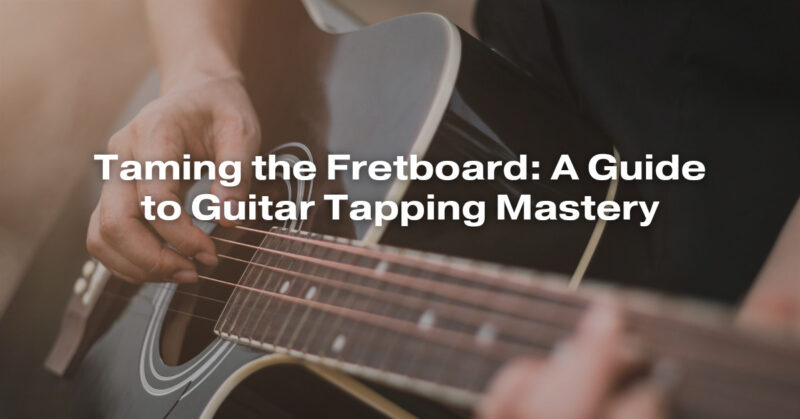Guitar tapping, a technique that involves using both hands to produce notes and melodies on the fretboard, has captivated audiences and inspired countless guitarists. From Eddie Van Halen’s iconic “Eruption” to Steve Vai’s intricate compositions, tapping is a powerful tool for creating dazzling solos and innovative sounds. In this guide, we’ll explore the art of guitar tapping and provide you with a step-by-step approach to mastering this captivating technique.
Understanding Guitar Tapping
Before we dive into the exercises, it’s essential to grasp the basics of guitar tapping:
1. Tapping Hand: The tapping hand, typically your fretting hand, is responsible for producing notes by tapping on the fretboard.
2. Supporting Hand: Your supporting hand, the picking hand, may rest on the strings to dampen unwanted noise or provide rhythmic accents.
3. Hammer-ons and Pull-offs: Tapping primarily involves using your tapping hand’s fingers to perform hammer-ons (tapping a note without picking) and pull-offs (releasing a tapped note to produce another).
4. Two-Hand Tapping: This technique combines both hands to create rapid and fluid sequences of notes and chords on the fretboard.
Step 1: Single-Hand Tapping Exercises
Begin by developing your tapping hand’s strength and accuracy with these exercises:
1. Single-Finger Tapping: Start with your index finger on the fretboard. Tap a note on a string, ensuring a clear and sustained sound. Practice this on multiple strings and positions.
2. Two-Finger Tapping: Progress to using both your index and middle fingers for tapping. Play sequences of notes using these two fingers, gradually increasing speed and complexity.
3. Finger Combinations: Incorporate your ring and pinky fingers for more intricate tapping patterns. Experiment with different finger combinations and develop a sense of finger independence.
4. String Skipping: Practice tapping on adjacent and non-adjacent strings. String skipping exercises will improve your precision and control.
5. Hammer-on and Pull-off Variations: Combine hammer-ons and pull-offs with your tapping. For example, tap a note, then perform a hammer-on and pull-off sequence with your tapping hand.
Step 2: Basic Two-Hand Tapping
Now, let’s explore basic two-hand tapping techniques:
1. Synchronized Tapping: Start with a simple tapping pattern that involves both hands. For example, tap a note with your tapping hand and an open string with your picking hand. Coordinate the two actions rhythmically.
2. Ascending and Descending Runs: Create ascending and descending tapping runs across the fretboard. Pay attention to timing and clarity of each note.
3. Tapping Arpeggios: Practice tapping arpeggios, such as major or minor triads, with both hands. These can be used in various musical contexts.
4. Tapping Chords: Experiment with tapping full chords or chord fragments with your tapping hand while your picking hand provides rhythm or additional notes.
Step 3: Advanced Tapping Techniques
To take your tapping skills to the next level, explore these advanced techniques:
1. Tapping Harmonics: Combine tapping with natural or artificial harmonics for ethereal and shimmering sounds.
2. Tapping Licks and Solos: Develop your own tapping licks and solos. Study the work of guitarists like Steve Vai, Joe Satriani, and Stanley Jordan for inspiration.
3. Polyphonic Tapping: Experiment with polyphonic tapping, where you tap multiple notes simultaneously to create lush chordal textures.
4. Tapping Across Multiple Octaves: Explore tapping across multiple octaves of the fretboard. This allows you to create expansive and dramatic musical landscapes.
5. Rhythmic Tapping Patterns: Develop complex and rhythmic tapping patterns that incorporate various time signatures and syncopation.
6. Tapping in Different Styles: Apply tapping to different musical styles, such as rock, metal, jazz, or fusion, to expand your versatility as a guitarist.
Step 4: Practice and Creativity
To master guitar tapping, consistent practice is key. Here are some additional tips:
1. Use a Metronome: Practice tapping exercises with a metronome to develop your timing and rhythmic precision.
2. Record Yourself: Record your tapping sessions to assess your progress and identify areas for improvement.
3. Experiment and Innovate: Don’t be afraid to experiment and create your tapping techniques. Innovation can lead to unique and groundbreaking sounds.
4. Apply Tapping to Songs: Incorporate tapping into your original compositions or adapt existing songs to include tapping sections.
5. Seek Inspiration: Listen to and study the work of guitarists known for their tapping prowess, and attend live performances to gain insights into their techniques.
Remember, mastering guitar tapping takes time and dedication. As you progress through these steps and exercises, you’ll unlock the full potential of this captivating technique, adding a new dimension to your guitar playing and expanding your musical horizons.


